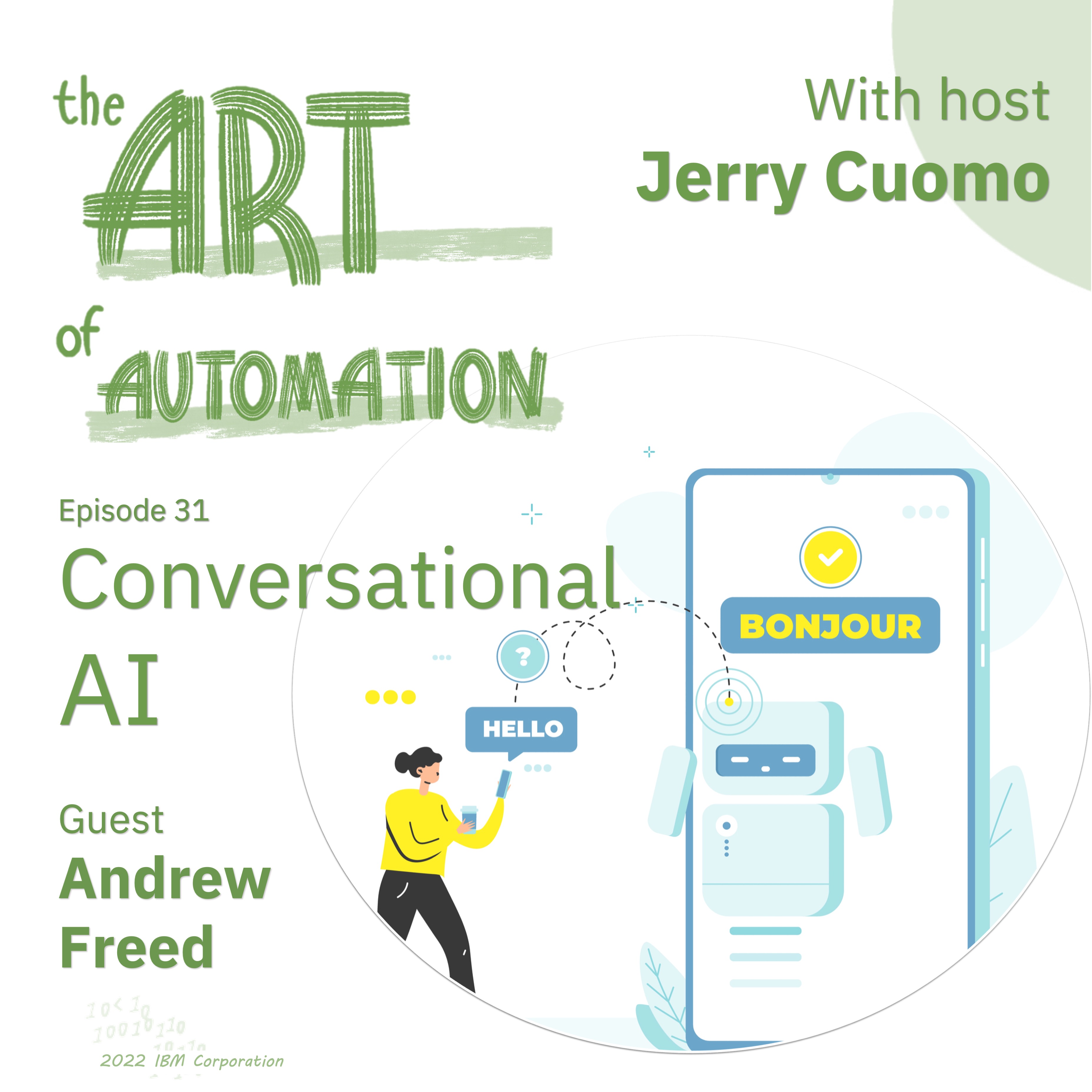Conversational AI with Andrew Freed
- 0.5
- 1
- 1.25
- 1.5
- 1.75
- 2
Speaker 1: From IBM cloud and cognitive software, you are listening to The Art of Automation with host, Jerry Cuomo.
Speaker 2: Hey. Welcome to The Art of Automation, a podcast that explores the application of automation in the enterprise. Hey folks, in 1966, Joseph Weizenbaum, a German scientist and professor at MIT developed the first chatbot called Eliza. This clever piece of software aimed at tricking accusers by making them believe that they were having a conversation with a real human being. Eliza was developed to imitate a therapist who would ask open- ended questions and even respond with follow- ups. So you would say something like," My mother cooks good food," and Eliza would pick up the word mother and respond by asking an open- ended question like," Tell me more about your family?" And this created an illusion of understanding and having an interaction with a real human. Well, today's chatbots have come a long, long way. They can handle complex requirements of large organizations like banks, insurance companies, and telcos, specifically today's chatbots are now AI powered. This enables their ability to understand human language and perform more complex tasks and transactions. In relation to chatbots, this branch of AI is called conversational AI, and this episode will be all about conversational AI. In fact, I am pleased to have Andrew Freed join me today. Andrew is a conversational AI expert and is the author of a book titled, yes, you guessed it, Conversational AI: Chatbots That Work. And with that, I'd like to welcome Andrew to The Art of Automation. Welcome Andrew.
Speaker 3: AJ. Thanks for having me, glad to be here.
Speaker 2: Oh, it's a pleasure. It's a pleasure. So Andrew, let's get into that first question. Can you tell the listeners why you love what you do?
Speaker 3: Sure. And I'll start by saying what I do in the first place. So I work in-
Speaker 2: Sure.
Speaker 3: IBM's Expert Labs Group, which means I help our customers build solutions. I like to think of it as either build it with me or teach me how to build it.
Speaker 2: Perfect.
Speaker 3: And so, we're a really collaborative group. I really enjoy that, and there's a nice variety of projects with Sheps. It's interesting, but what I like even better is sort of the real- world impact. So as an example, COVID- 19 was a very exciting time or interesting time for all of us.
Speaker 2: Right.
Speaker 3: And for one of my customers, it actually shut down one of their call centers.
Speaker 2: Oh boy.
Speaker 3: The people couldn't come in. This was healthcare. So people need healthcare. They need to make these phone calls, and essentially they sent more phone calls to our Watson Assistant solution, and we kept the lights on. We kept things going, people were getting their healthcare, they were getting what they needed, and that was a really cool thing. inaudible
Speaker 2: Yeah. I can see why you love that.
Speaker 3: Yeah.
Speaker 2: I know you're an author of a book called Conversational AI. What inspired you to write this book?
Speaker 3: I've done a lot of reading in my life and I very much want to give back to folks who read like me. I saw one time, a cool analogy about... they said, "Look, imagine there's a tapestry of world knowledge and it's this huge quilt that covers like the United States or something. And when you're writing, you're essentially adding your quilt square."
Speaker 2: Nice.
Speaker 3: And it says, "Well, it's not much, but it's a new square and it wasn't there before, and I'll take it."
Speaker 2: Nice.
Speaker 3: Yeah. So the book is for folks who are in the orbits of conversational AI. I typically aim for the builders, but I think even if you find yourself as a user of conversational AI, it'll kind of help you understand what's going on behind the curtain and how can I succeed with this thing?
Speaker 2: What is conversational AI and how would you recognize it?
Speaker 3: Sure. Let's say you're calling some company and instead of a person picking up, you can tell it's a machine. They're not hiding it from you, it's an automated voice. And you're probably used to," Hey, press one for this, press two for that." And that was kind of like a dumb phone tree kind of view where it's very-
Speaker 2: Right.
Speaker 3: Very strictly coded, but when it's more free formed," Hey, tell me what you need? How can I help you?" You are not given these strict instructions and you can in fact, drive a call to resolution on your own. That's to me is what conversational AI is.
Speaker 2: Oh yeah, Andrew. And when these things are done right, they can change a user's experience dramatically. In fact, I got to tell you this, recently I went to renew my car's registration with the State of North Carolina's Department of Motor Vehicle. It was amazing and it worked. We had a conversation, the AI bot was quite helpful, informing me, in fact that I had to get my car inspected first, before I got it registered. And if you think of what this guided experience is replacing, before I would've had to go and trot down in person into the DMV. In fact, I would've gotten turned away because of a lack of car inspection, and I would've been frustrated with the time loss. So pause and think what I just said, conversational AI, delightful experience and DMV, all in the same sentence. So I agree with you, Andrew, conversational AI is indeed chatbots done right. So what would you consider to be the biggest takeaways from the book?
Speaker 3: I look at as like why are we doing the things that we're doing? And I'm actually going to call back to... I believe it came from your book if I'm not mistaken. One of your guests was talking about chatbots and they said," Well, software needs testing and chatbots are software. Therefore chatbots need testing."
Speaker 2: Yes, yes.
Speaker 3: I thought, hey, that was great. That's sort of my mantra for the next few years. I've worked with people to build these things, but they look at like," Well, how do I actually test the thing?"
Speaker 2: Right.
Speaker 3: And how do I do the steps I need to do? And why am I doing them in the first place?
Speaker 2: Right.
Speaker 3: So I want to give you why you're doing all these things, and how you can actually steer it off the rails? You can train too much for instance, or you can test in a way that's not very efficient of your time.
Speaker 2: No, that makes a lot of sense, Andrew, because as I kind of get more experience with AI and users of AI, I see one of the biggest inhibitors is trust.
Speaker 3: Yes.
Speaker 2: Is the software going to respond in a way that would emulate a human's response? And could I trust that? And I would assume that comes at the expense of some great amount of testing. So I really appreciate what you just said there.
Speaker 3: It absolutely does, and if you'll... Tremendous story about this.
Speaker 2: I love stories.
Speaker 3: I was working with a customer and they have... it's not just a simple Q& A bot. They have a full process flow and you can self- service through it, but what that means is your phone call's going to be a couple questions long.
Speaker 2: Right.
Speaker 3: As it does a little back and forth with you. And so they had looked at, let's say question four or five or something like that. And they said," Well, there's 50 things that we're going to allow the user to say." And their first instinct was," Well, I'm going to get on the phone and call it 50 times. And each time, I'm going to go through this one minute phone call and I'm going to get to that spot. And I'll say a different word each time." And if you think about it, that's an extremely boring hour-
Speaker 2: Right.
Speaker 3: First of all, and secondly, there is no ability to repeat that at all. So the direction I'm trying to steer is, look, let's break this down into components. Let's think like we traditionally think of unit testing and integration testing with software.
Speaker 2: Right.
Speaker 3: So let's test speech recordings of those 50 phrases, just the phrases without the phone call. We'll very quickly find out how accurate we are with those. Let's run another test with the words and see if the Watson engine knows what the words mean. Right?
Speaker 2: Right.
Speaker 3: And let's run a third series where we run it through an API dialogue flow and say," Okay, can it handle the sequence?" And at the end of it, we can prove it to ourselves with a voice call, but we don't need to start with the voice call.
Speaker 2: I see. That's pretty cool. So let's keep on this topic of tools, and I know Watson Assistant is featured in several of the examples in your conversational AI book. What are the tools of the trade? And I notice there's not a lot of programming in Java, Go, Python here.
Speaker 3: Yeah.
Speaker 2: So it seems that there's a lot of low code, no code going on. So can you just kind of share with the audience, what are the tools of the trade and what kind of skills do you need to build conversational AI bots?
Speaker 3: Yeah. So that is absolutely the direction, low code and no code, and I think the lows are going to the nose. That's definitely a direction I'm seeing and really, with a lot of these tools, and I think Watson is in front of these, but they essentially started with," Look, what do you think you're going to hear first? And what should it do? And what do you think about a Q& A bot that's sort of it?" Or if you have a process oriented bot, that's the first step, but you can go pretty far with that. So whether you're doing one of these to check on your health insurance, or whether you're coding something to control your home, turn off the lights and turn on the music and that sort of thing, it all kind of starts the same way. And in the first chapter, I walked through a couple of examples, how I've simplified my life with my iPhone once I learned voice commands. I'm like," Oh, I don't even need to know where the apps are anymore. I can just say what I want." And I've walked through," Hey, here's how your Alexa works, and then here's how you do some of these things in Watson Assistant." And I find that the tools have a lot of the same concepts, and maybe the terminology is slightly different, but they're all for the most part pointed in the same direction.
Speaker 2: Yeah. No, I like the book because it used Watson Assistant as an example of a tool, but I think users of other tools would get great benefit from your guidance and direction.
Speaker 3: Absolutely. And I tried to call out the terminology. I haven't used a lot of these other tools, but I did some research. So hopefully you can find the notes that you need if you're looking at another tool.
Speaker 2: So Andrew, what do you see? We mentioned the issue of trust in conversational AI. What other issues are out there?
Speaker 3: The feedback cycles are still a little long. I think it's like any other software where time from the idea or the conception to when you can deliver it, chatbots are in the end, no different. You still have to do that kind of flow with them, and it can be a challenge of," Hey, how do I want to design this so that I can quickly iterate if I need to."
Speaker 2: Great. Where do you see this all going in the future, Andrew?
Speaker 3: I see it's increasing. I think for the folks who are building them, the cost savings are real. The time to value is real and there's a lot of excitement in building, and now that we're getting more people building, I think every single part's going to get easier, whether you're a builder, whether you're a tester, whether you're a user. I think you're going to use more of these things and they're going to understand you better, and they're going to behave better because everyone's watching the way everyone else builds.
Speaker 2: That's a great point because the users become the builders. I know doing home automation, I guess I'm a builder, but I'm constructing through voice command. So I'm constructing and I'm doing sequences of turning lights on, and dimming the shades, and all of that kind of stuff. So it's very interesting. I do see the tools getting better and more intuitive. So that's great. Well, with that Andrew, time flies when you're having fun. I want to thank you for joining us on The Art of Automation. Really good luck with the book going forward and all of the wonders that are conversational AI. Thank you.
Speaker 3: Thanks so much for having me, Jerry.
Speaker 2: Well, that's it for today. And once again, Andrew's book is called Conversational AI: Chatbots That Work. I've included in a link in this episode's description, where you can get Andrew's book at a discount, and give a shout out to Andrew and I on LinkedIn if you need to build a bot that works as a means to kick off your automation journey. And speaking of your automation journey, The Art of Automation book is also available, and you can find a link in the description section as well. And royalties for the art of automation book are being donated to the American Cancer Society. Okay. Once again, I'd like to thank Andrew. And of course, I'd also like to thank all of you for listening in again. This is Jerry Cuomo, IBM Fellow and VP for Technology at IBM. See you again on an upcoming episode.
DESCRIPTION
Conversational AI is the topic of this episode where Jerry Cuomo is joined by Andrew Freed, author of Conversational AI –Chatbots that work.
Today’s chatbots have come a long way. They can handle complex requirements of larger organizations like banks, insurance companies and telcos… Specifically today’s chatbots are now AI-powered. This enhances their ability to understand human language and perform more complex tasks and transactions. In relation to chatbots, this branch of artificial intelligence is called conversational AI.
During the episode you will hear Andrew and Jerry discuss the art of designing, developing, and deploying human-like AI solutions that chat with your customers, solve their problems, and streamline your support services.
Connect with Jerry on LinkedIn here. And Jerry’s Digital Twin (DJ) here.
Here is a link to Andrew’s book – Conversational AI: Chatbots that work. With Discount code: FREEDPC
Also buy the Paperback of Art of Automation here.
Buy a signed copy of Paperback Book here.
Royalties from Art of Automation book are donated to the American Cancer Society.
Today's Host








